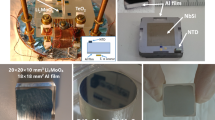Summary
It is conceivable that the recently discovered ceramic superconducting materials, withT c>72 K, like the Ba2YCu3O6.9, could be employed in the construction of a new generation of massive low-energy neutrino detectors, without prohibitively sophisticated cryogenic system. In this paper I discuss the detection of low-energy neutrinos via the coherent neutral-current elastic scattering, with an «ideal» detector, whose sensitivity is quantum limited. It is well known that coherent elastic scattering is the dominant interaction of neutrinos with De Broglie wavelength smaller than nuclear size, orE ν≪200 MeV/A 1/3, and it is insensitive to the neutrino flavour. Therefore, a measurement of the solarneutrino flux with this type of detector could give a definitive solution to the solar-neutrino puzzle.
Riassunto
È concepibile che i nuovi materiali ceramici superconduttori, conT c>72 K, come ad esempio il Ba2YCu3O6.9, possano essere impiegati nella costruzione di una nuova generazione di rivelatori di neutrini con grande massa, senza la necessità di ricorrere a sistemi criogenici proibitivamente complicati. In questo lavoro si discute la rivelazione di neutrini di bassa energia attraverso lo scattering coerente di corrente neutra su nucleo, per mezzo di un rivelatore «ideale», la cui sensibilità sia vicina al limite quantistico. È ben noto infatti che lo scattering coerente è l'interazione dominante di neutrini la cui lunghezza d'onda di De Broglie sia piú piccola delle dimensioni del nucleo, ossia conE ν≪200 MeV/A 1/3, e non dipende dal tipo di neutrino. Perciò una misura del flusso di neutrini solari con un rivelatore di questo tipo è in grado di risolvere definitivamente il problema dei neutrini solari.
Резюме
Отмечается, что недавно открытые керамические сверхпроводящие материалы сT c>72K, подобные Ba2YCu3O6.9, могут быть использованы для конструирования нового поколения детекторов нейтрино низких энергий без сложных криогенных систем. В этой статье обсуждается детектирование низкоэнергетичных нейтрино с помощью когерентного упругого рассеяния нейтрального тока в «идеальном» детекторе, чувствительность которого ограничена квантовыми эффектчми. Хорошо известно, что когерентное упругое упругое рассеяние является доминирующим взаимодействием нейтрино с длиной волны де Бройля меньше размеров ядра илиE ν≪200 МэВ/А1/3, и явдяется не чувствительным к аромату нейтрино. Измерения потока соднечных нейтрино спомощью детектора такого типа, по-видимому, позволит решить проблему солнечных нейтрино.
Similar content being viewed by others
References
R. Davies, D. S. Harmer andK. C. Hoffman:Phys. Rev. Lett.,20, 1205 (1968).
Seee.g.,R. Davies: inProceedings of the VII Workshop on Grand Unification, ICOBAN, April 1968, Toyama, Japan, and references therein.
J. N. Bahcall:Rev. Mod. Phys.,50, 881 (1978).
J. N. Bahcall, W. F. Huebner, S. H. Lubow, P. D. Parker andR. K. Ulrich:Rev. Mod. Phys.,54, 767 (1978). For a recent discussion see alsoW. A. Fowler:Nucleosynthesis: Challenges and New Developments, edited byW. D. Arnett andJ. W. Turan (The University of Chicago Press, Chicago, Ill., 1985), p. 8.
B. Pontecorvo:J.E.P.T.,34, 247 (1958).
T. K. Kuo andJ. Pantaleone:Phys. Rev. Lett.,57, 1805 (1986).
S. P. Mikheyev andA. Yu. Smirnov:Sov. J. Nucl. Phys.,42, 913 (1985).
L. Wolfenstein:Phys. Rev. D,17, 2369 (1978).
H. A. Bethe:Phys. Rev. Lett.,56, 1305 (1985).
E. W. Kolb, M. S. Turner andT. P. Walker:Phys. Lett.,175, 478 (1986);S. P. Rosen andJ. M. Gelb:Phys. Rev. D,34, 969 (1986).
L. M. Krauss, S. L. Glashow andD. Schramm:Nature,310, 190 (1984).
P. O. Lagage:Nature,316, 420 (1985).
D. Z. Friedman:Phys. Rev. D,9, 1389 (1974).
D. J. Ficenec, S. P. Ahlen, A. A. Marin, J. A. Musser andG. Tarlè:Phys. Rev. Lett., in press.
S. P. Ahlen, F. T. Avignone III, R. L. Brodzinski, A. K. Drukier, G. Gelmini andD. N. Spergel: CFA Preprint No. 2292, March 25, 1986.
B. Cabrera, L. M. Krauss andF. Wilczek:Phys. Rev. Lett.,55, 25 (1985).
A. K. Drukier andL. Stodolsky:Phys. Rev. D,30, 2295 (1984).
L. D. Landau andE. M. Lifschitz:Statistical Physics, Part. 2 (Mc Graw Hill, New York, N.Y., 1980), p. 190 ff.
Author information
Authors and Affiliations
Additional information
To speed up publication, the author of this paper has agreed to not receive the proofs for correction.
Переведено редакцией.
Rights and permissions
About this article
Cite this article
Auriemma, G. Solar-neutrino detection with ceramic superconductors. Nuov Cim A 100, 119–129 (1988). https://doi.org/10.1007/BF02902645
Received:
Published:
Issue Date:
DOI: https://doi.org/10.1007/BF02902645




